Outdoor Bouldering: The Ultimate Beginner’s Guide (2024)

Bouldering is one of the most popular disciplines of rock climbing, along with indoor climbing and sport climbing. It’s also the least technical and most affordable, which makes it a great choice for new climbers!
The majority of climbers learning bouldering today will head indoors, but outdoor rock is where the fun really is. In this article, we’ll learn everything we need to know about tackling bouldering problems outside.
What Is Bouldering?
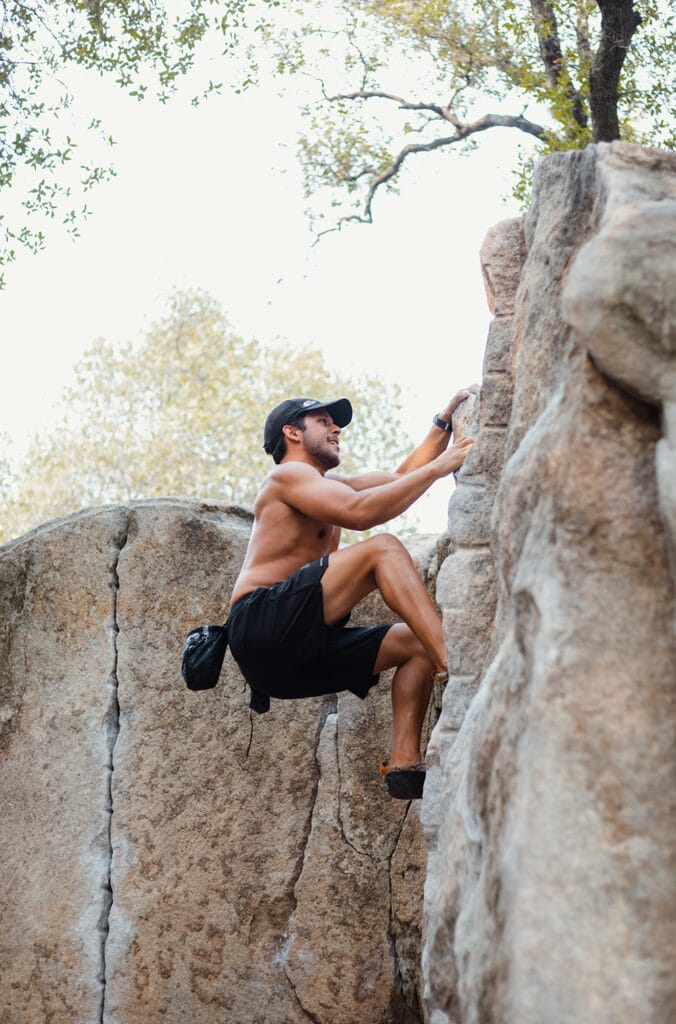
Bouldering is the art of scaling short rock faces, typically freestanding boulders, without a rope or harness, using only a crash pad to protect against falls. Like trad and sport climbing, bouldering is a type of free climbing. Although boulder problems are usually only a handful of moves, bouldering movement is highly technical and strenuous. As opposed to stamina or endurance, boulderers focus on power and strength.
Bouldering began in the early 1900s, pioneered in England’s Lake District by mountaineers like Oscar Eckenstein and Aleister Crowley, as well as in France’s famed Fontainebleau sector, by figures like Pierre Allain. However, it wasn’t developed as its own rock climbing discipline until the mid-1900s, under the thumb of American mathematician and gymnast Jon Gill.
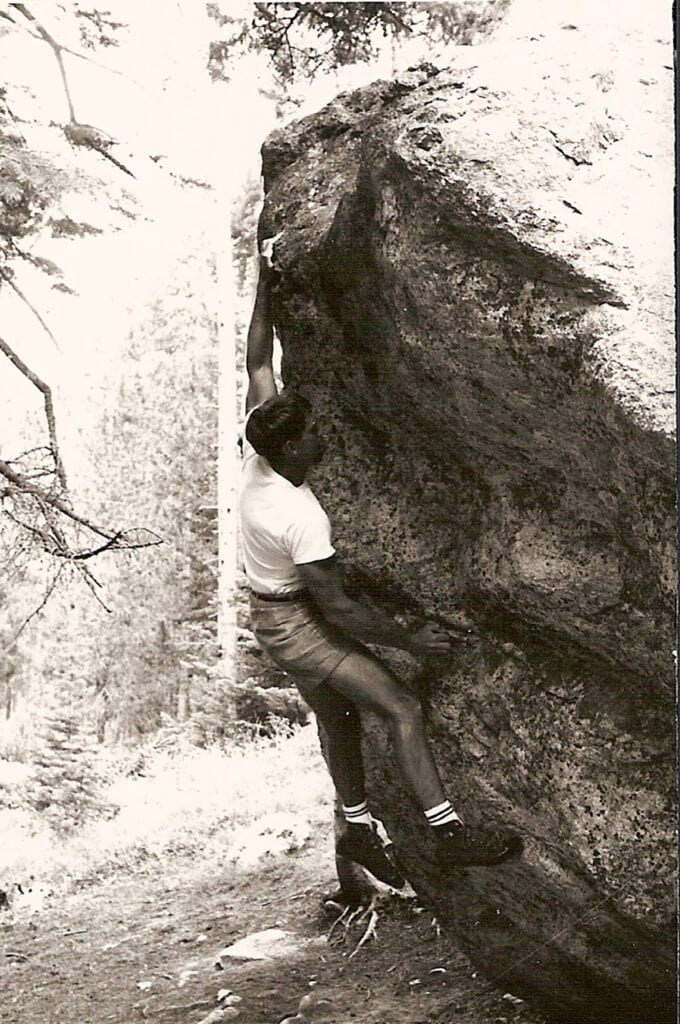
Gill was the world’s first boulder specialist, and is generally considered the “father of modern bouldering” (you can read a short profile I wrote of him, 1). Gill introduced many of the sport’s modern tools and techniques, like the use of magnesium carbonate (gymnastic chalk) and controlled dynamics. He also pioneered many of the most popular training regimens in use today and introduced the first grading system specifically designed for bouldering.
Bouldering Outdoors
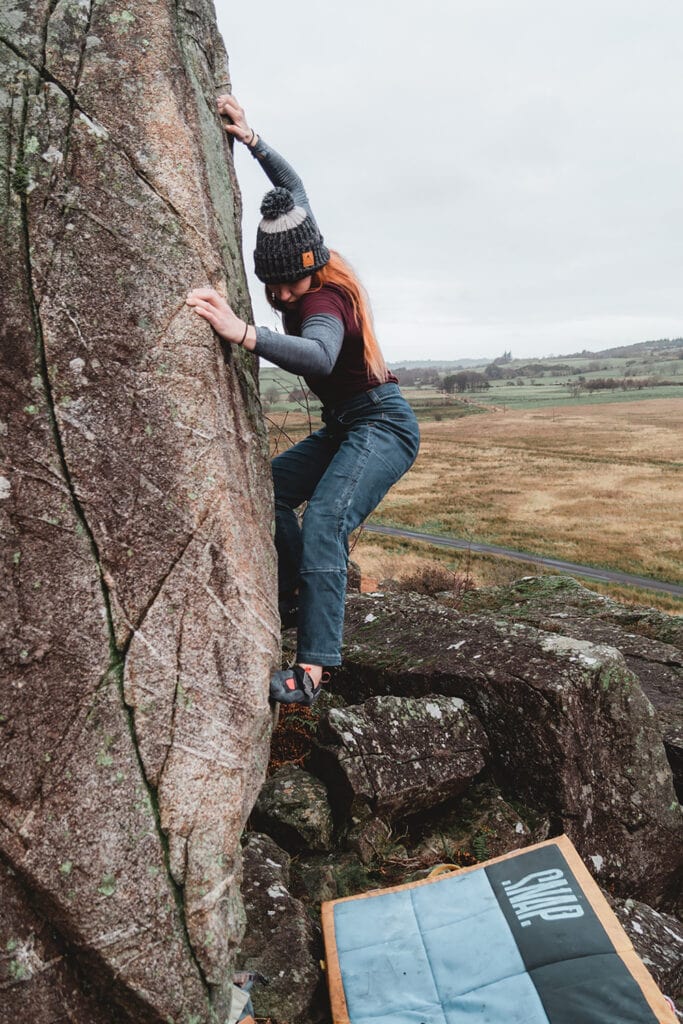
What Are Boulders?
A boulder is simply a large rock, one at least too large for a human to move. However, bouldering can refer to tackling any short climbing route (usually 15 feet/5 meters or lower), whether on a larger rock face, boulder, or other freestanding formation.
Types of Rock
There are myriad rock types, each with unique characteristics, but almost any rock is climbable under good conditions (i.e. temperate climes, dry, clear of vegetation). Wet rock, for example, is best avoided. Climbers will also often talk about “choss,” meaning rock that is unsuitable for climbing, usually because it’s too loose, soft, or covered with vegetation.
In the broadest sense, the five categories of rock for climbing are sedimentary (such as sandstone and limestone), metamorphic (such as quartzite), igneous plutonic (such as granite), igneous volcanic (such as most basalts), and hydrothermal and metasomatic (such as quartz).
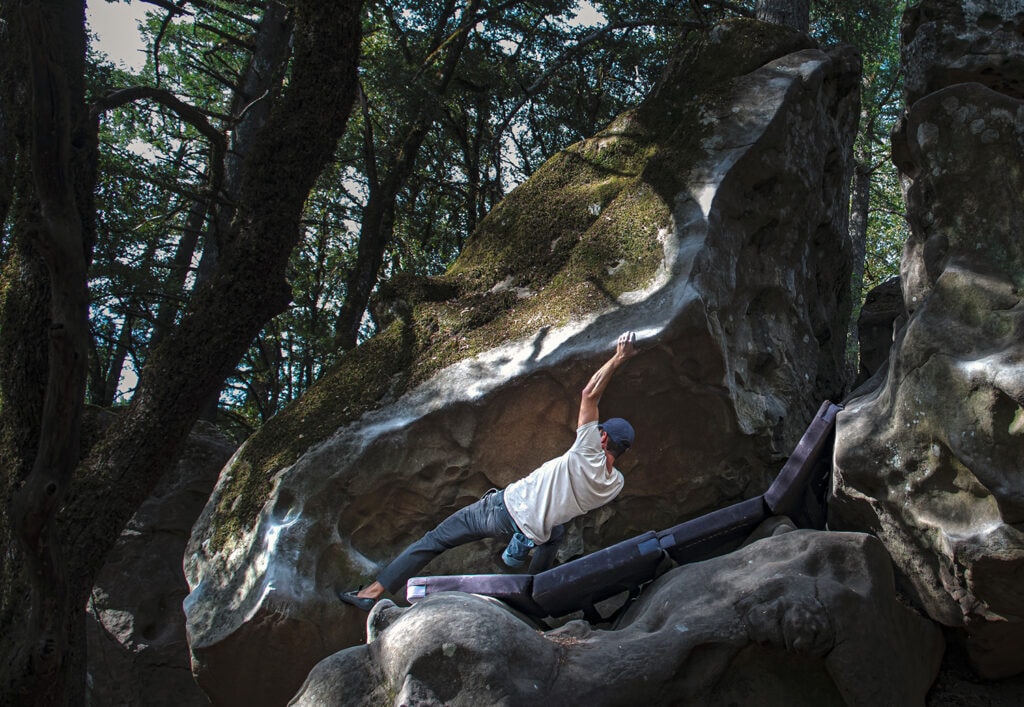
Height
As noted above, bouldering problems are usually around 8 to 15 feet (2 to 5 meters) in height. Some problems, known as “lowballs,” can be as low as four or five feet (1.5 meter), while others, known as “highballs,” can go upwards of 20 feet (6 meters). Once you stretch into 30 feet (9 meters) and beyond, a highball essentially becomes a free solo.
Is Outdoor Bouldering Safe?
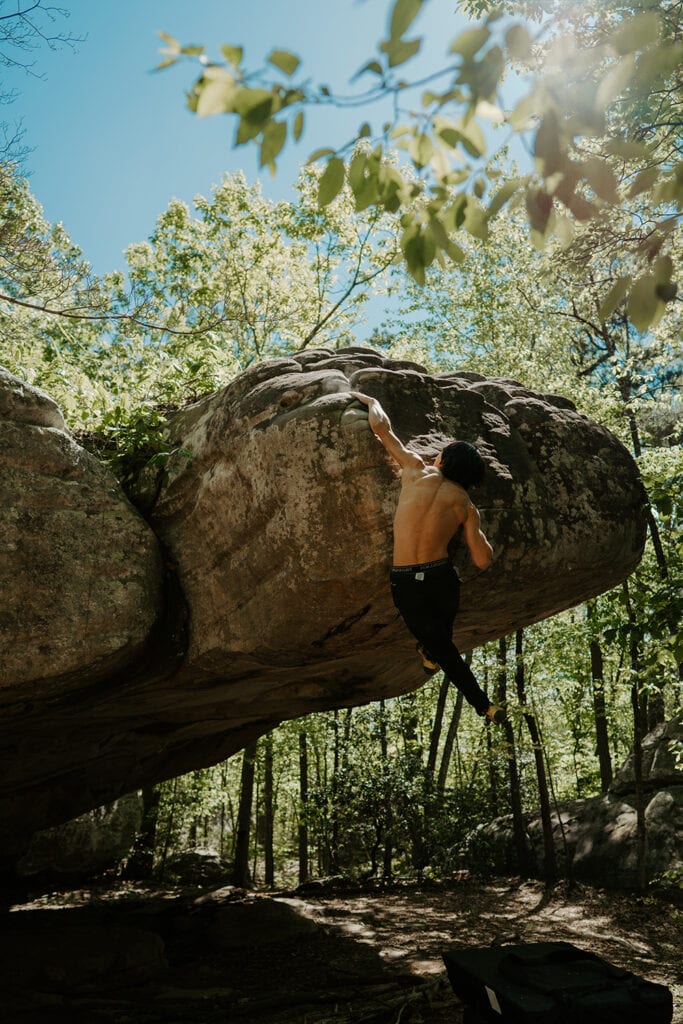
Risk
As noted above, a boulder problem can range from a four-foot lowball to a 25-foot highball, so bouldering is as safe or as dangerous as you choose. But unlike a rock gym (which has pads over the entire landing surface), while outside you have to protect the climb all by yourself. The outdoors isn’t a controlled environment like a gym.
Proper pad placement, reliable spotters, and good technique and body positioning (both while climbing and falling) are all essential to a safe bouldering experience.

Bouldering Crash Pads
Bouldering crash pads are the only piece of protection a boulderer has, so it’s crucial that you have a solid pad (or two) in your arsenal. Pads vary widely in thickness, diameter, weight, and style, so do your research before purchasing. Check out our selection of the best bouldering crash pads for more info.
The Art of Spotting
One of the key ways to mitigate bouldering risk is by using spotters. Spotters are other climbers who stand below you while you boulder, ready to ensure that a) you land on your pad and b) you land on your feet, or as close to it as possible.

Being a good spotter is somewhat intuitive, but it’s much more difficult than it seems. We could probably write an entire article about the art of spotting. Here are a few tips:
- Keep your hands up at all times, and keep your fingers closed, making “spoons” with your hands, not “forks.”
- Don’t stand underneath the climber. Your job isn’t to catch them. Your job is to correct their fall trajectory, pushing them onto the pad and pushing their body the right way up if they aren’t falling feet first.
- Constantly evaluate your climber’s potential fall line (i.e. where they’ll hit the ground if they fall), and move the pad as it changes. The climber’s feet aren’t always a good indicator of where they’ll fall!
Approach and Recon
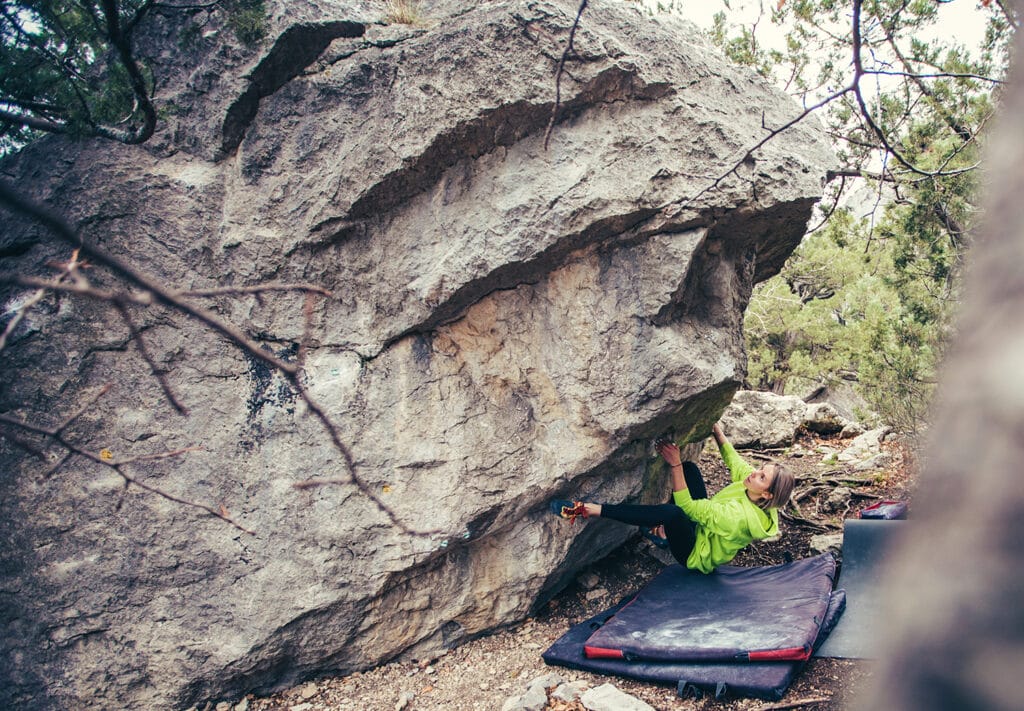
Approaching a bouldering area is a key part of the process. Research your approach beforehand, and bring proper footwear, adequate food & water, and other trail essentials. Not all boulderfields are a stone’s throw from the car. Some require a decent hike to access! A few safety tips follow:
- Check the weather before you head outdoors. Climbs in the cold or rain are no fun!
- Be wary of top outs! Top outs can be quite tricky and you often don’t have the opportunity to practice them indoors.
- Real rock is usually much rougher than plastic. Skin injuries are common. Bring tape and balm, this will pay dividends.
- Check your fall zone for rocks, tree branches, and other debris. Also, be aware of the angle of your fall zone. A flat, level landing area is always ideal, but sometimes not possible. In these cases, be especially wary of how and where you’re falling.
- Consider your descent. Not all boulders are easily descended. Some require a technical down climb that is a bouldering problem in and of itself, or at the very least a high jump down onto a pad. On some highballs, experienced climbers actually bring a rope and harness to rappel from the top.
Grades
Unlike roped climbing, bouldering has its own grading style. There are also several different grading systems depending on where you’re bouldering, including the UK B-scale and the numbered Fontainebleau (European) scale.
In the United States, the most commonly used grading system is the Hueco or V-scale. Problems range from V0 up to V17, increasing in difficulty as they go, although all but the most experienced boulderers will generally stay in the V8 and below range. For more on climbing grades and conversions, check out our dedicated page on grading systems, charts, and conversions.
How to Start Bouldering Outdoors
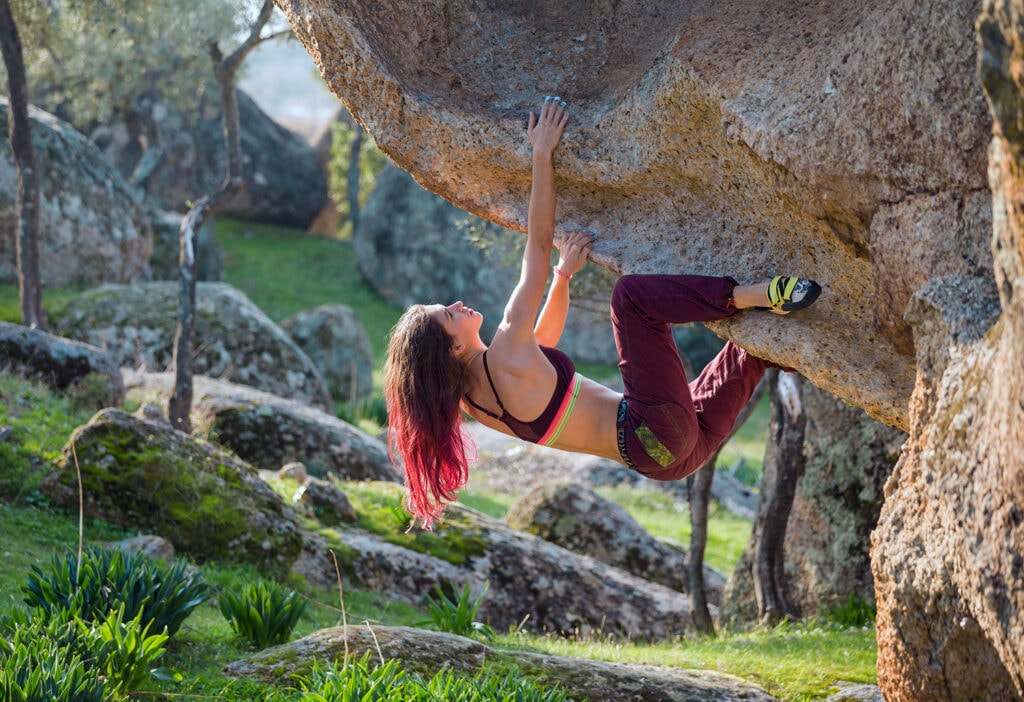
Practical Tips
Transitioning from indoors to outdoors when bouldering isn’t as hard as doing so with roped climbing. There are no knots to tie, gear to place, or anchors to build. In general, the same principles apply, although you have to be aware of a few new dangers, particularly with regard to falling. Here are some tips.
Practice Falling
Falling outside is very different than falling in a gym, where the entire floor is flat and heavily padded. When you’re outdoors, you only have a few pads (sometimes only one) at your disposal to protect your fall, and they’re usually much thinner than those at your gym. The ground is also uneven and can contain obstacles like rocks, branches, or tree trunks. It’s easy to break an ankle!
It’s imperative that you land on your pad, and land feet first. Practice controlled falls from a few easy problems before you go all-in on harder problems, so that you can learn how to land.

Educate Yourself Online
In addition to written “How-To” guides like ours, there are tons of YouTube tutorials that can help you learn some bouldering basics, from safe pad placement and spotting to proper body movement and training. Do some e-research before you head out!
Take a Course
While there aren’t many bouldering-specific courses because of the lack of technical knowledge needed to practice this discipline, there are plenty of guides who can take you bouldering and show you the ropes (ha!), demonstrating the movement and technique required to safely send hard.
Go with friends
While it’s definitely possible to go bouldering alone, going with friends is the best way to start. More friends means more pads and more spotters, dramatically increasing your safety, and your projecting ability! It also means you have more time to take breaks while others climb!
What You Need for Outdoor Bouldering

The best thing about bouldering is how simple it is, compared to other outdoor climbing disciplines. A boulderer only needs two pieces of gear: a crash pad and climbing shoes.
Most also bring a chalk bag or chalk bucket. Beyond this, there is no necessary equipment, but climbing tape, skin repair balm, and nail clippers may also come in handy. It’s also a good idea to bring water and a snack.
What to Wear
The clothes you wear for bouldering are generally no different than what you might wear for any other climb. However, because bouldering is particularly gymnastic and dynamic, focus on loose-fitting, flexible apparel. When bouldering during warmer months, breathable material is also a great idea.
Where to Go Bouldering Outdoors?
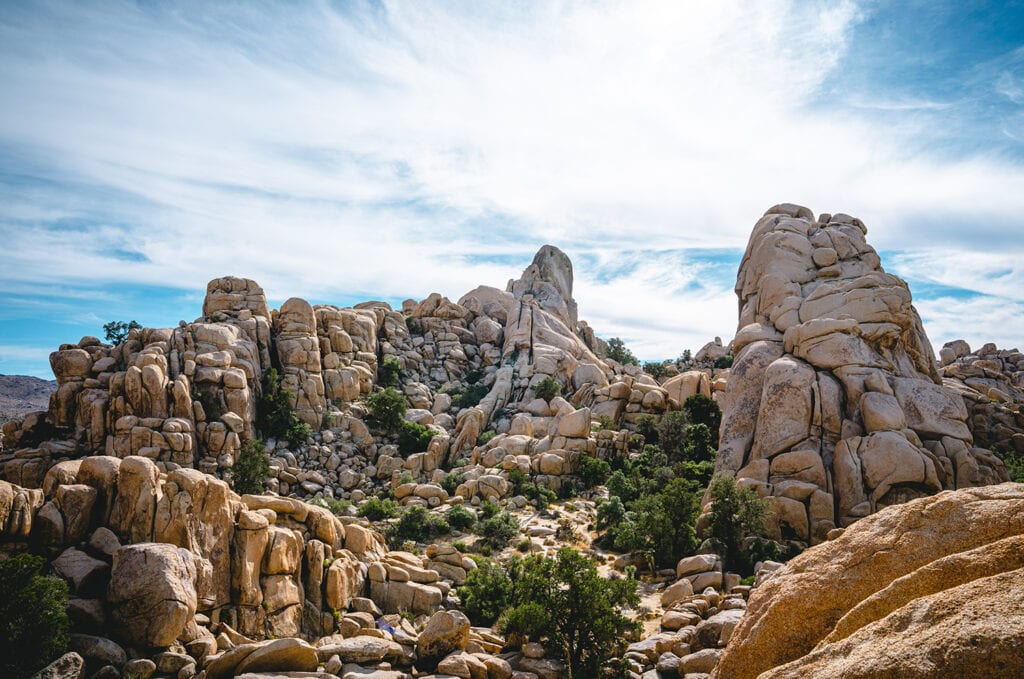
There are dozens of bouldering areas in the United States. Three of my personal favorite crags for beginners are Horse Pens 40 (AL), Joshua Tree (CA), and Rumbling Bald (NC). These boulderfields all have simple access, plenty of easy problems, great to build confidence and learn technique on real rock, as well as plenty of harder problems to work up to, and an overall beautiful area to camp and climb in.
Other popular bouldering areas for beginners include the sandstone at Rocktown & Stone Fort (TN), Hueco Tanks (TX), Red Rock (NV), Rocky Mountain National Park (CO), the Gunks (NY), Devil’s Lake (WI), and Holy Boulders (IL).
Switching from Indoor to Outdoor Bouldering
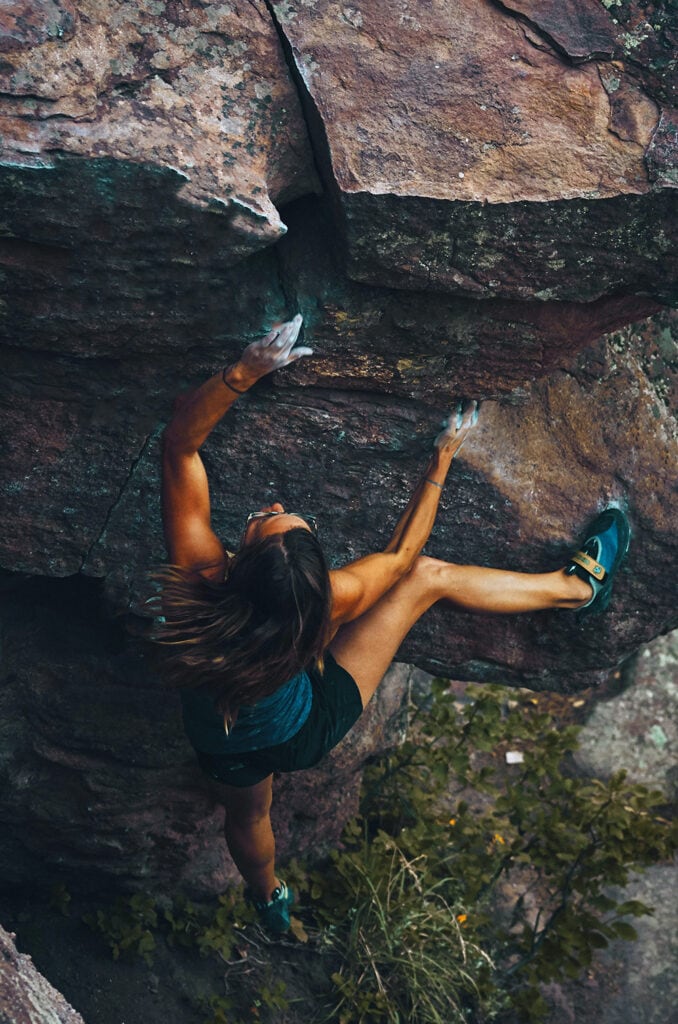
Important Things to Consider
Bouldering outside isn’t necessarily dangerous, but it requires you to accept a good bit more risk. From weather conditions to rock quality, wild animals, poor landing zones, and more, there are many more risk factors to consider on the real rock.
Above all else, start small when you head outside. Don’t jump on a big or difficult problem right off the bat. Stick with easily protected, shorter VO and V1 problems until you feel comfortable with a harder climb. Take a break if you’re feeling pumped out. The consequences of a big fall are much higher than in the gym.

Also, remember to respect the land and other climbers. Check with local regulations before you bring your dog, and avoid playing loud music when others are around. Also, be sure not to leave anything behind you! That includes food scraps, human waste, and chalk tick marks (if at all possible). All of these things can cause issues with land managers, leading to access problems.
Is It Better to Start with Indoor or Outdoor Bouldering?
The answer depends on the climbers you ask. Indoor bouldering is certainly safer and more controlled, but outdoor bouldering offers a more authentic experience and still doesn’t require any technical knowledge, like sport or trad climbing. Both inside and outside are perfect places to start your bouldering journey!
Is Outdoor Bouldering Harder than Indoor Bouldering?
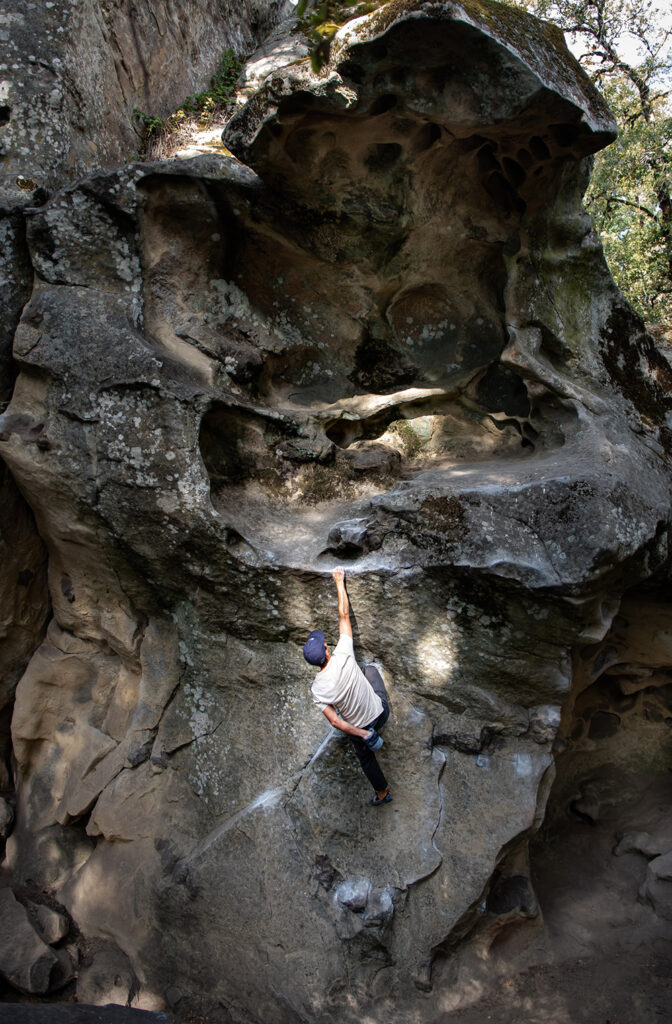
Grading
In theory, bouldering inside and outside is identical. Indoor and outdoor problems use the same grades, although some gyms will use their own corresponding scale of shapes and colors instead of the V-scale (or Font).
Ultimately grading will depend on your outdoor bouldering area and your home gym, but usually climbing outdoors is harder than climbing indoors. Holds aren’t marked, and the sequence for the problem is less clear. The psychological element also comes into play… Climbing outside is much scarier than climbing in a safe, controlled gym environment.
Because of all these factors, most outdoor climbers project one or two grades below their gym grade. If you climb V4 in a gym, be ready to flounder on some V2s outside!
References
John Gill, Father of Bouldering
Climbing (retrieved on 05/26/2023)
https://www.climbing.com/people/john-gill-father-of-bouldering/
